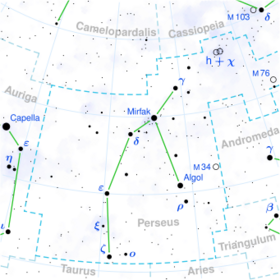Astronomy:Lambda Persei
| Observation data Equinox J2000.0]] (ICRS) | |
|---|---|
| Constellation | Perseus |
| Right ascension | 04h 06m 35.04360s[1] |
| Declination | 50° 21′ 04.5500″[1] |
| Apparent magnitude (V) | 4.29[2] |
| Characteristics | |
| Spectral type | A0IVn[3] |
| U−B color index | −0.04[2] |
| B−V color index | +0.02[2] |
| Astrometry | |
| Radial velocity (Rv) | +6.1±2.0[4] km/s |
| Proper motion (μ) | RA: −12.75[1] mas/yr Dec.: −35.60[1] mas/yr |
| Parallax (π) | 7.73 ± 0.22[1] mas |
| Distance | 420 ± 10 ly (129 ± 4 pc) |
| Absolute magnitude (MV) | −1.31[5] |
| Details | |
| Radius | 3.1[6] R☉ |
| Luminosity | 348[5] L☉ |
| Surface gravity (log g) | 4.05[7] cgs |
| Temperature | 10,585[7] K |
| Metallicity [Fe/H] | +0.01[7] dex |
| Rotational velocity (v sin i) | 196[8] km/s |
| Age | 345[9] Myr |
| Other designations | |
| Database references | |
| SIMBAD | data |
λ Persei, Latinized as Lambda Persei, is a star in the northern constellation of Perseus. It is visible to the naked eye as a faint, white-hued point of light with an apparent visual magnitude of 4.29.[2] This object is located approximately 422 light years from the Sun based on parallax,[1] and is drifting further away with a radial velocity of +6 km/s.[4]
This object has a stellar classification of A0IVn,[3] matching an A-type subgiant star with "nebulous" lines due to rapid rotation. It is spinning with a projected rotational velocity of 196 km/s,[8] which is giving the star an equatorial bulge that is an estimated 16% larger than the polar radius.[11] Unusually for a star of this type, spectra show weak emission features among the Hydrogen lines, which may be due to plage regions on the surface caused by an implied magnetic field.[12] The star is 345[9] million years old and is radiating 348[5] times the luminosity of the Sun from its photosphere at an effective temperature of 10,585 K.[7]
In Chinese astronomy, Lambda Persei is called 積水, Pinyin: Jīshuǐ, meaning Stored Water, because this star is marking itself and stand alone in Stored Water asterism, Stomach mansion (see : Chinese constellation).[13]
References
- ↑ 1.0 1.1 1.2 1.3 1.4 1.5 Van Leeuwen, F. (2007). "Validation of the new Hipparcos reduction". Astronomy and Astrophysics 474 (2): 653–664. doi:10.1051/0004-6361:20078357. Bibcode: 2007A&A...474..653V. Vizier catalog entry
- ↑ 2.0 2.1 2.2 2.3 Ducati, J. R. (2002). "Catalogue of Stellar Photometry in Johnson's 11-color system". CDS/ADC Collection of Electronic Catalogues 2237. Bibcode: 2002yCat.2237....0D.
- ↑ 3.0 3.1 Cowley, A. et al. (April 1969). "A study of the bright A stars. I. A catalogue of spectral classifications". Astronomical Journal 74: 375–406. doi:10.1086/110819. Bibcode: 1969AJ.....74..375C.
- ↑ 4.0 4.1 Wilson, R. E. (1953). General Catalogue of Stellar Radial Velocities. Carnegie Institution for Science. Bibcode: 1953GCRV..C......0W.
- ↑ 5.0 5.1 5.2 Anderson, E.; Francis, Ch. (2012). "XHIP: An extended hipparcos compilation". Astronomy Letters 38 (5): 331. doi:10.1134/S1063773712050015. Bibcode: 2012AstL...38..331A. Vizier catalog entry
- ↑ Pasinetti Fracassini, L. E. et al. (February 2001), "Catalogue of Apparent Diameters and Absolute Radii of Stars (CADARS)", Astronomy and Astrophysics 367 (2): 521–524, doi:10.1051/0004-6361:20000451, Bibcode: 2001A&A...367..521P
- ↑ 7.0 7.1 7.2 7.3 Wu, Yue et al. (2010). "Coudé-feed stellar spectral library – atmospheric parameters". Astronomy & Astrophysics 525: A71. doi:10.1051/0004-6361/201015014. Bibcode: 2011A&A...525A..71W.
- ↑ 8.0 8.1 Hoffleit, D.; Warren, W. H. (1995). "Bright Star Catalogue". VizieR On-line Data Catalog: V/50. Originally Published in: 1964BS....C......0H 5050. Bibcode: 1995yCat.5050....0H.
- ↑ 9.0 9.1 Gontcharov, G. A. (November 2012). "Spatial distribution and kinematics of OB stars". Astronomy Letters 38 (11): 694–706. doi:10.1134/S1063773712110035. Bibcode: 2012AstL...38..694G.
- ↑ "lam Per". SIMBAD. Centre de données astronomiques de Strasbourg. http://simbad.u-strasbg.fr/simbad/sim-basic?Ident=lam+Per.
- ↑ Belle, G. T. (2012). "Interferometric observations of rapidly rotating stars". The Astronomy and Astrophysics Review 20: 51. doi:10.1007/s00159-012-0051-2. Bibcode: 2012A&ARv..20...51V.
- ↑ Underhill, Anne B. (November 1991). "Lambda Persei: an Unusual B9 IV Star". Publications of the Astronomical Society of the Pacific 103: 1176. doi:10.1086/132937. Bibcode: 1991PASP..103.1176U.
- ↑ (in Chinese) AEEA (Activities of Exhibition and Education in Astronomy) 天文教育資訊網 2006 年 7 月 11 日
 |



